Women's History Month is an annual declared month that highlights the contributions of women to events in history and encourages the study, observance, and celebration of the vital role of women in American history.
Each week throughout March, we have posted short biographies about some of the women who have made a lasting impact on the community of Vashon Island.
Please see below to learn more about some of these amazing women.
Captain Gertrude Wiman
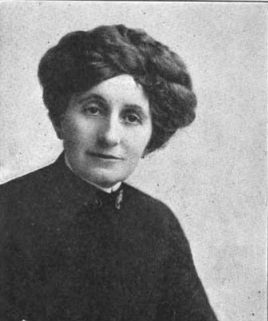 Captain Gertrude Wiman, who was known for always dressing in black when she skippered a boat, was the first woman licensed as a steamship pilot on Puget Sound. She married Captain Chance Wiman in 1889, moved to Vashon in 1894, and had a son Frederick born in 1897. Gertrude worked with Chance as a purser and accompanied him on many of his runs learning the art of running a steamer to the point that in 1907 she passed the exam and was awarded her second-class pilots license for Puget Sound from Olympia to Port Townsend.
Captain Gertrude Wiman, who was known for always dressing in black when she skippered a boat, was the first woman licensed as a steamship pilot on Puget Sound. She married Captain Chance Wiman in 1889, moved to Vashon in 1894, and had a son Frederick born in 1897. Gertrude worked with Chance as a purser and accompanied him on many of his runs learning the art of running a steamer to the point that in 1907 she passed the exam and was awarded her second-class pilots license for Puget Sound from Olympia to Port Townsend.
When Chance died in 1928, Gertrude stopped working steamers and concentrated on her social life on Vashon. She and Chance had built a magnificent home on the north shore of Quartermaster Harbor that was one of the “show places of the entire island.” Gertrude was a charter member of the Vashon Island Order of the Eastern Star, a Masonic organization primarily for women with a relationship to a Master Mason, and served as Worthy Matron in 1923. She was persuaded to come out of retirement in 1938 to pilot the Puget Sound Freight Lines diesel steamer Indian in a 4th of July race on Elliot Bay against the Skagit River Navigation Company sternwheeler Skagit Chief.” said Captain E.F. Lovejoy, owner of the Indian. “With women entering all lines of business and making it plenty tough for the men, I feel that Mrs. Wiman may be the deciding factor.” And, he was right. The Indian did win the race with Gertrude Wiman as co-pilot with the ship’s regular skipper Bart Lovejoy.
Lucy Slagham Gerand
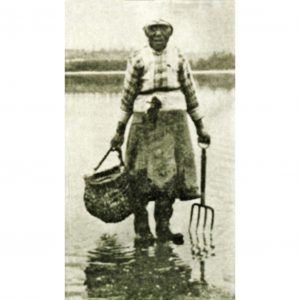 Born in about 1843, Lucy was raised in a longhouse on the shore of inner Quartermaster Harbor. Her people were the sx̌ʷəbabš, which means “Swiftwater People.” As a young girl, she went with her parents to witness the signing of the Treaty of Medicine Creek in 1854. The resulting treaty negotiated between the tribes of south Puget Sound and Washington Territorial officials resulted in extinguishing Native claim to all their territory except for small reservations.
Born in about 1843, Lucy was raised in a longhouse on the shore of inner Quartermaster Harbor. Her people were the sx̌ʷəbabš, which means “Swiftwater People.” As a young girl, she went with her parents to witness the signing of the Treaty of Medicine Creek in 1854. The resulting treaty negotiated between the tribes of south Puget Sound and Washington Territorial officials resulted in extinguishing Native claim to all their territory except for small reservations.
Native sx̌ʷəbabš people, including Lucy and her family, were imprisoned on Fox Island during the treaty war of 1855-56. When the war ended, they moved to the Puyallup Reservation. In 1893, when the reservation was broken up into individual allotments, Lucy and her first husband John Slagham received an allotment on Hylebos Creek on the tidelands of Tacoma, where they lived on a houseboat. Lucy continued to travel to Vashon where she was well-known to early settlers.
In about 1896, Lucy and John sold their reservation allotment and moved to Vashon. A year after John’s death in 1903, Lucy married Tom Gerand. They bought land on Maury Island in 1906, but lived on their houseboat in a small lagoon at Jensen Point. Lucy dug clams for trade with homesteaders and to sell to restaurants in Tacoma.
It is thanks to Lucy’s 1918 interview with anthropologist Thomas T. Waterman and her 1927 testimony about the sx̌ʷəbabš villages to a U.S. Court of Claims that we have first-hand evidence of the sx̌ʷəbabš people’s longhouses and lifeways on Vashon-Maury Islands. Lucy died in 1929 and was buried in the Vashon Cemetery. In 2008, the Puyallup Tribe placed a headstone to honor their ancestor.
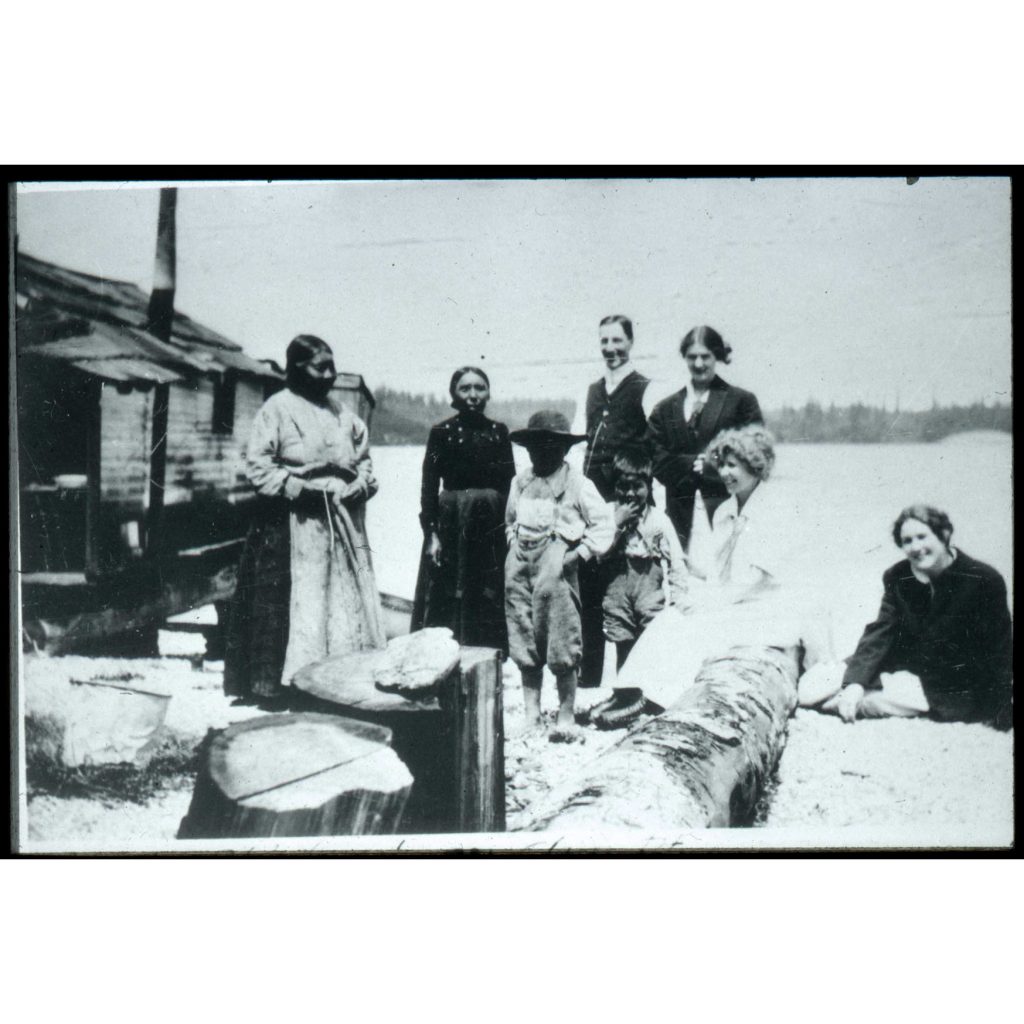
Back to top.
Agnes Smock
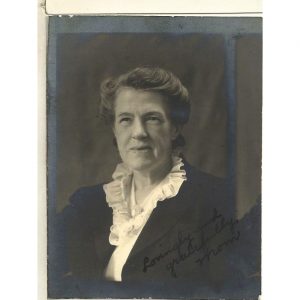 Agnes Smock was an amazing Vashon woman. She was the owner of the Vashon Island News-Record from 1920 to the beginning of World War II, and after her husband left her with three young children, she became the sole owner, editor, and working single Mom for nearly two decades.
Agnes Smock was an amazing Vashon woman. She was the owner of the Vashon Island News-Record from 1920 to the beginning of World War II, and after her husband left her with three young children, she became the sole owner, editor, and working single Mom for nearly two decades.
Agnes was far ahead of her time. She developed a staff who were all women, she was a fearless campaigner for open government, and she championed the Vashon Japanese American community at a time when not all islanders were welcoming.
Except for the Business Manager/Printer, C.J. Denny, all the newspaper reporters were women. During the 1920s and 1930s, each area of the Island had its own designated correspondent, and each week much of the newspaper consisted of reports from each community. Also, at this time, women were identified in the newspaper by their husband’s name, not by their own name.
This is one area where Agnes and the Island were not quite ready to break new ground, although Agnes identified herself as Mrs. Agnes Smock after her husband left her.
Mrs. S.R. Hearst covered Center, Mrs. Graham Maloney covered Lisabeula, Miss Bertha Smith covered Southern Heights, Mrs. L.H. Larson covered Maury, Mrs. A.J. Stuckey covered Dockton, Mrs. A. Hunt covered Burton, and Mrs. Alfred Olsen covered Cross’ Landing.
Another notable contribution by Agnes Smock occurred in 1930 as the new Vashon Union High School was being built after voters approved joining Burton High School and Vashon High School into one island-wide unified high school.
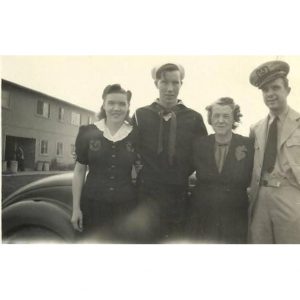 Agnes wrote a full-length frontpage editorial in the March 6, 1930 paper entitled “Are the Affairs of Our High School in a Shady Plight?” In the editorial she asserted, “If the charge that inferior material and workmanship is going into the very foundation of our high school then drastic action should be taken at once to remedy the condition.” She continued that the high school board had the attitude that “the less the public knew, the better.” “No doubt the high school board has been honest in their endeavors, but according to the opinion of many they have erred in judgement.”
Agnes wrote a full-length frontpage editorial in the March 6, 1930 paper entitled “Are the Affairs of Our High School in a Shady Plight?” In the editorial she asserted, “If the charge that inferior material and workmanship is going into the very foundation of our high school then drastic action should be taken at once to remedy the condition.” She continued that the high school board had the attitude that “the less the public knew, the better.” “No doubt the high school board has been honest in their endeavors, but according to the opinion of many they have erred in judgement.”
Agnes Smock concluded her editorial with the rousing statement “NOW is the time for the taxpayers to take a businesslike attitude and interest in what is going on. … Charges of maladministration should be either proven true and corrected, or they should be proven false and forgotten. Until this is done, we are laying a foundation of distrust and suspicion that will prove poor material upon which to build permanently the greatest institution of a civilized community, our public schools.” Because of her outspoken criticism, the News-Record was banned from being placed in the cornerstone of the new high school. Vashon Union High School opened in 1932 and served the community until it was replaced by a new high school in 1973.
A third major contribution of Agnes Smock to the Vashon community was her outspoken support for the Japanese American community. As editor of the News-Record she always included reports on the activities and contributions of Vashon’s Japanese American residents. Her editorial of August 28, 1941 celebrated the Vashon Japanese American community organizing to help the defense effort. Four days after Pearl Harbor her editorial called for “Dual Responsibility” to prevent the “irresponsible element, individuals with poor sense of balance, who stir up trouble and seek to inflame prejudice” from creating “serious situations in times like this.” In March 1942 she printed “The Creed of Japanese-Americans” adopted by the Japanese-American Club of Vashon Island that proclaimed “I am proud that I am an American citizen of Japanese ancestry.”
Two days before the Island’s Japanese American community was removed, exiled and imprisoned on May 16, 1942, Agnes’s editorial proclaimed, “We Part With Mutual Regret.” She writes that as “our good friends and neighbors prepare to leave the homes and community they have loved as well as we who stay … We hope … that we may again work together for the good of Vashon Island when these unhappy times shall end.”
Marjorie Rose Stanley
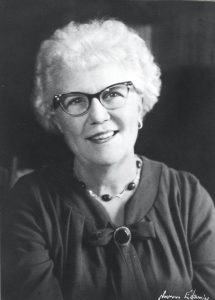 Words and laughter shaped Marjorie Rose Stanley’s long life. Her interest in people inspired her to fill her writings with memorable stories and portraits of the individuals who built early farms and businesses, and to write two book-length histories in her later years, Search for Laughter; a History of Vashon-Maury Island (1967) and Historical… Sometimes Hysterical… Rhymes of Vashon-Maury Island (published posthumously in 1984).
Words and laughter shaped Marjorie Rose Stanley’s long life. Her interest in people inspired her to fill her writings with memorable stories and portraits of the individuals who built early farms and businesses, and to write two book-length histories in her later years, Search for Laughter; a History of Vashon-Maury Island (1967) and Historical… Sometimes Hysterical… Rhymes of Vashon-Maury Island (published posthumously in 1984).
Born in New York in 1891, Marjorie crossed the continent by train when her family moved to Seattle in 1895. From their Queen Anne Hill house, they descended to the boardwalk streets of early Seattle and observed Princess Angeline selling baskets at the foot of Madison. Carting their household to Vashon on a steamer in 1905, they boarded with Sol and Eliza Sherman until their house was built on adjoining land. “Sol Sherman had long white whiskers, and the patience of Job when it came to a little girl’s tagging him about. He and his dumpling of a wife Eliza, were idols in my eleven-year-old eyes,” she recalled.
Marjorie started school with college! Vashon College that is, described as a military school for young men and boys, and a seminary for young ladies. When her older brothers Bert and Clifford enrolled in 1902, she joined them at age 11 and attended until they graduated. Burton High School had been built in 1904, so she transferred there in the fall of 1905 and in 1909, was one of five students in the first graduating class.
After graduation, she studied stenography, worked as secretary at Tacoma’s Stadium High School, attended classes at the University of Washington, became an interior decorator, and for a few months had a tea room in Bremerton until the Depression forced it to close. She raised money for various charities, wrote and directed plays and hosted many social events. For many years she wrote columns for local Vashon newspapers.
Her playwriting efforts were integral to the operations of Vashon’s first library, which had been started in 1916 by the Burton Women’s Club. Though it received donated books and moved to corners of various Burton stores for the first few years, it needed cash to pay rent when it moved into the new Burton Post Office building in 1920. Writing plays, helping rehearse and stage them became a regular part of Marjorie’s activities. It seemed natural that she was hired in 1943 to become Vashon’s first librarian.
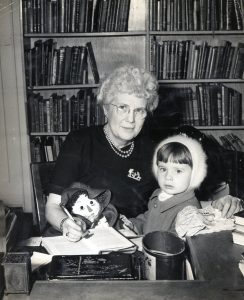 Marjorie served as librarian and hostess at the Vashon Library until 1962. She hosted teas and art shows, making the library a community gathering place. She filled many scrapbooks with newspaper stories about new books, library activities and Vashon events. Other scrapbooks preserved photos of island children and Christmas cards from the library’s regulars. Under Marjorie’s supervision the library entered Strawberry Festival parades with children costumed as characters in their favorite books (except for one young girl who in 1957 carried a sign reading “I am not a character”!).
Marjorie served as librarian and hostess at the Vashon Library until 1962. She hosted teas and art shows, making the library a community gathering place. She filled many scrapbooks with newspaper stories about new books, library activities and Vashon events. Other scrapbooks preserved photos of island children and Christmas cards from the library’s regulars. Under Marjorie’s supervision the library entered Strawberry Festival parades with children costumed as characters in their favorite books (except for one young girl who in 1957 carried a sign reading “I am not a character”!).
In November of 1926, the Vashon News-Record published the first “History of Vashon Island”, which included stories Marjorie collected from many early settlers. Her book Search for Laughter: A History of Vashon-Maury Island was serialized in the Beachcomber in 1967. Having lived on the island more than sixty years, she had known many of the early families and kept an extensive card file and collection of photos and mementoes. Based on these resources, she told lively stories of her own life on Vashon, as well stories of her friends, neighbors, and important events. A second book, titled Historical…Sometimes Hysterical Rhymes of Vashon-Maury Island also profiled people she had known. It was published by the Beachcomber Press in 1984. In it, her postscript reads:
"There are lots more folks and places I'd like to write about,
but - I'm sorry - I can't do it, for I'm just plain tuckered out.
Now, cheer up, history readers! Preserve your cozy nook.
No doubt you'll read about them in some future history book!"
Marjorie Rose Stanley died on April 10, 1981, at the age of 89, after a life of service to her community.

